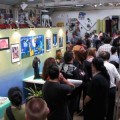Light might well be the most distinctive mark of mankind on the surface of the planet. From space, continents glow and light clusters indicate where people are gathered. Artists long have “painted with light” metaphorically, but at the beginning of the 21st century, light became the medium for a new art form. Using computer programming, the artist creates and sets in motion a sequence of actions expressed in light and directed by mathematical rules or algorithms, then allows that sequence to play itself out without intervention.
Appropriately for its Silicon Valley location, the San Jose Museum of Art has presented some stunning exhibitions of technology-enabled art, notably the “Jennifer Steinkamp” exhibition of 2006, in which that artist’s installations of animated light consumed the viewer in total environments of undulating color and form, harking back to the 20th-century video art of Bill Viola and others. Another exhibit of that same year, “Edge Conditions,” featured cutting-edge digital art.
The current “Leo Villareal” exhibition at the San Jose Museum of Art reveals, more than any exhibit I’ve seen, an evolutionary moment in technology-enabled art. The “objects” of transmission are themselves elegant: the 10-by-15-foot wall of mirror-finished stainless steel with hundreds of recessed LED lights of Diamond Sea; a dozen naked horizontal LED tubes in Chasing Rainbows with just enough space between them to act as a pinstripe shadow in the colorful streams of light, while the black curving wires and plugs at the end of each 8-foot tube frame the motion of light that goes through them. The light sequences appear to be completely random.
Villareal’s sequences are set in motion by sometimes complex rules—the exhibition provides an opportunity for the viewer to understand the process by playing the Game of Life, in which the participant creates an initial configuration of LED-lit cells, then sees how the rules—such as “any live cell with fewer than two live neighbors dies”—play out to the end.
The for-all-intents-random sequence of, say, tiny colored LED lights on or off behind a screen of Plexiglass, as in Primordial, compels the viewer to “make sense” of the pattern, to attribute values to the coalescing and separating and apparently directional movement of light, even to see a narrative unfold. In these works, Leo Villareal plays the Zen Frankenstein mimicking the primordial organization of life. Perhaps the magic is only the echo of our cells responding.
Leo Villareal
Through Jan. 9
San Jose Museum of Art




